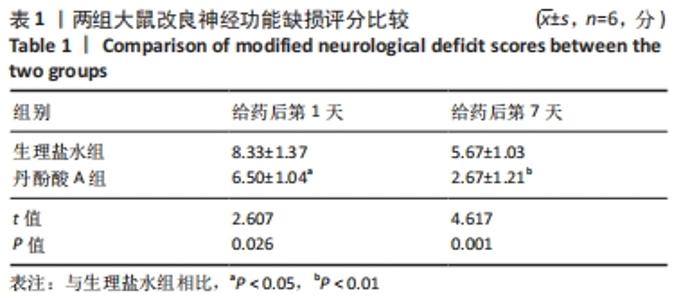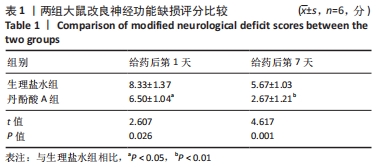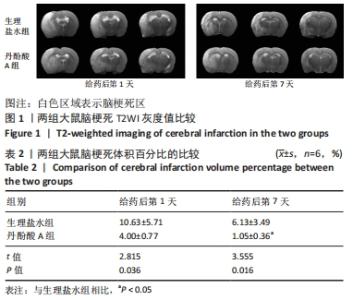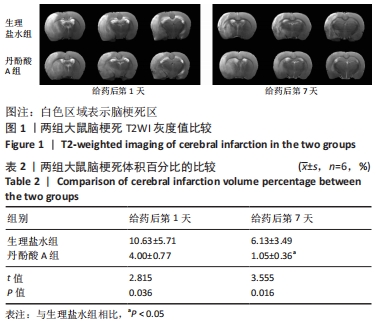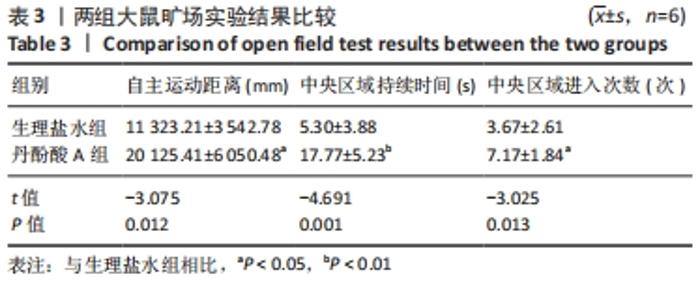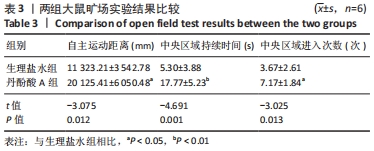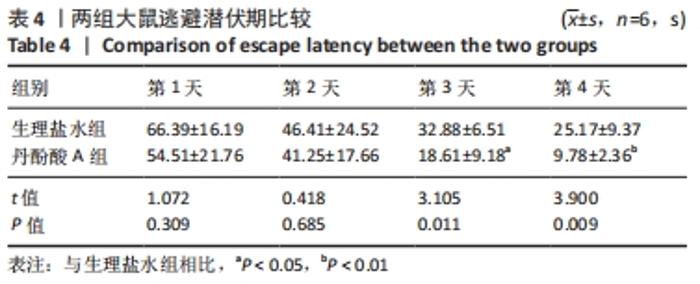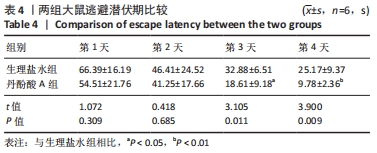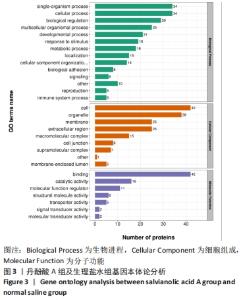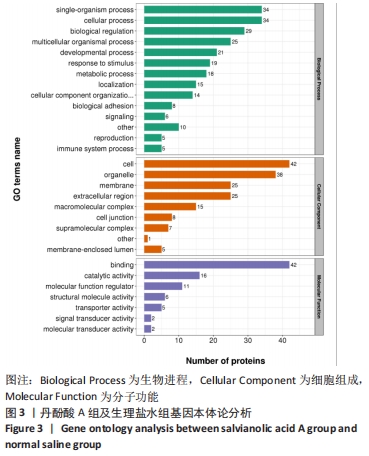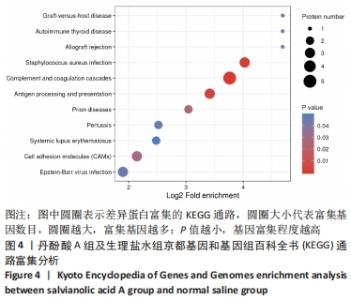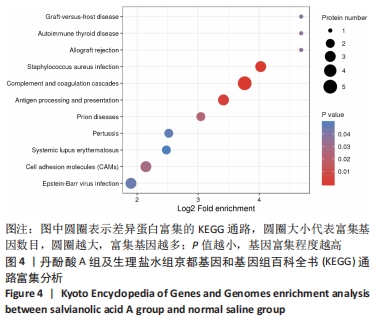Chinese Journal of Tissue Engineering Research ›› 2022, Vol. 26 ›› Issue (23): 3714-3720.doi: 10.12307/2022.672
Previous Articles Next Articles
Salvianolic acid A effects on hippocampal protein expression in ischemic stroke rats: a tandem mass tag-based proteomic analysis
Xu Wenshan1, Jiang Pingli1, Liu Yulu1, Ding Yanyi1, Yu Yan1, Yang Minguang1, Liu Weilin2, 3, Chen Lidian3
- 1College of Rehabilitation Medicine, 2Academy of Rehabilitation Industry, Fujian University of Traditional Chinese Medicine, Fuzhou 350122, Fujian Province, China; 3National & Local Joint Engineering Research Center for Rehabilitation Medical Technology, Fuzhou 350122, Fujian Province, China
-
Received:2021-09-13Accepted:2021-10-22Online:2022-08-18Published:2022-02-22 -
Contact:Liu Weilin, Associate professor, College of Rehabilitation Medicine, Fujian University of Traditional Chinese Medicine, Fuzhou 350122, Fujian Province, China; Academy of Rehabilitation Industry, Fujian University of Traditional Chinese Medicine, Fuzhou 350122, Fujian Province, China -
About author:Xu Wenshan, Master candidate, College of Rehabilitation Medicine, Fujian University of Traditional Chinese Medicine, Fuzhou 350122, Fujian Province, China -
Supported by:the Major Expenditure Increase/Decrease Project at the Central Level, No. 2060302 (to LWL)
CLC Number:
Cite this article
Xu Wenshan, Jiang Pingli, Liu Yulu, Ding Yanyi, Yu Yan, Yang Minguang, Liu Weilin, Chen Lidian. Salvianolic acid A effects on hippocampal protein expression in ischemic stroke rats: a tandem mass tag-based proteomic analysis[J]. Chinese Journal of Tissue Engineering Research, 2022, 26(23): 3714-3720.
share this article
Add to citation manager EndNote|Reference Manager|ProCite|BibTeX|RefWorks
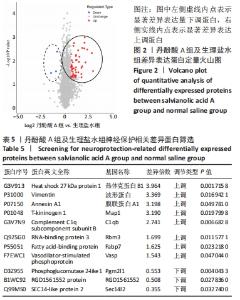
2.6 蛋白质鉴定及差异表达蛋白质筛选 采用TMT标记定量蛋白组学的方法分析两组大鼠海马区蛋白表达的差异,结果分析得到7 257个共有蛋白。根据标准筛选差异表达蛋白表达变化的倍数超过1.5倍,同时满足P < 0.05。与生理盐水组相比,丹酚酸A组大鼠海马区的53种蛋白质水平发生显著变化,其中50个差异表达蛋白表达上调,3个差异表达蛋白表达下调,蛋白定量结果统计以火山图形式展示。对差异蛋白逐一进行检索,发现这些差异蛋白主要参与肿瘤转移、细胞周期调控、氧化应激、炎症反应、免疫调控、血流调节、血管生成等,其中具有神经保护作用的蛋白包含热休克蛋白B1(Heat shock 27 kD)、波形蛋白、膜联蛋白A1等,见图2及表5。"
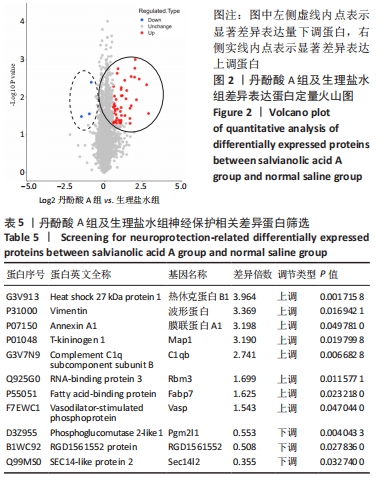
| [1] CAMPBELL BCV, DE SILVA DA, MACLEOD MR, et al. Ischaemic stroke. Nat Rev Dis Primers. 2019;5(1):70. [2] Qin T, Rasul A, Sarfraz A, et al. Salvianolic acid A & B: potential cytotoxic polyphenols in battle against cancer via targeting multiple signaling pathways. Int J Biol Sci. 2019;15(10):2256-2264. [3] Wu Y, Xu S, Tian XY. The Effect of Salvianolic Acid on Vascular Protection and Possible Mechanisms. Oxid Med Cell Longev. 2020:5472096. [4] Kuriakose D, Xiao Z. Pathophysiology and Treatment of Stroke: Present Status and Future Perspectives. Int J Mol Sci. 2020;21(20):7609. [5] Zhang W, Song JK, Zhang X, et al. Salvianolic acid A attenuates ischemia reperfusion induced rat brain damage by protecting the blood brain barrier through MMP-9 inhibition and anti-inflammation. Chin J Nat Med. 2018;16(3):184-193. [6] Jiao CX, Zhou H, Yang CX, et al. Protective efficacy of a single salvianolic acid A treatment on photothrombosis-induced sustained spatial memory impairments. Neuropsychiatr Dis Treat. 2017;13:1181-1192. [7] Zhang F, Wu Y, Jia J, et al. Pre-ischemic treadmill training induces tolerance to brain ischemia: involvement of glutamate and ERK1/2. Molecules. 2010;15(8):5246-5257. [8] Chen J, Li Y, Wang L, et al. Therapeutic benefit of intravenous administration of bone marrow stromal cells after cerebral ischemia in rats. Stroke. 2001;32(4):1005-1011. [9] Caliskan H, Akat F, Tatar Y, et al. Effects of exercise training on anxiety in diabetic rats. Behav Brain Res. 2019;376:112084. [10] Yu L, Duan Y, Zhao Z, et al. Hydroxysafflor Yellow A (HSYA) Improves Learning and Memory in Cerebral Ischemia Reperfusion-Injured Rats via Recovering Synaptic Plasticity in the Hippocampus. Front Cell Neurosci. 2018;12:371. [11] Elgendy IY, Mahmoud AN, Mansoor H, et al. Evolution of acute ischemic stroke therapy from lysis to thrombectomy: Similar or different to acute myocardial infarction? Int J Cardiol. 2016;222: 441-447. [12] Yu KH, Cho SJ, Oh MS, et al. Cognitive impairment evaluated with Vascular Cognitive Impairment Harmonization Standards in a multicenter prospective stroke cohort in Korea. Stroke. 2013;44(3): 786-788. [13] XU AH, SUN YX. Research hotspots and effectiveness of repetitive transcranial magnetic stimulation in stroke rehabilitation. Neural Regen Res. 2020;15(11):2089-2097. [14] Levine DA, Galecki AT, Langa KM, et al. Trajectory of Cognitive Decline After Incident Stroke. JAMA. 2015;314(1):41-51. [15] Guo X, Yuan J, Wang J, et al. Calcitriol alleviates global cerebral ischemia-induced cognitive impairment by reducing apoptosis regulated by VDR/ERK signaling pathway in rat hippocampus. Brain Res. 2019;1724:146430. [16] Lin R, Yu K, Li X, et al. Electroacupuncture ameliorates post-stroke learning and memory through minimizing ultrastructural brain damage and inhibiting the expression of MMP-2 and MMP-9 in cerebral ischemia-reperfusion injured rats. Mol Med Rep. 2016;14(1):225-233. [17] Zhang X, Shen X, Dong J, et al. Inhibition of Reactive Astrocytes with Fluorocitrate Ameliorates Learning and Memory Impairment Through Upregulating CRTC1 and Synaptophysin in Ischemic Stroke Rats. Cell Mol Neurobiol. 2019;39(8):1151-1163. [18] WANG WJ, ZHONG YB, ZHAO JJ, et al. Transcranial pulse current stimulation improves the locomotor function in a rat model of stroke. Neural Regen Res. 2021;16(7):1229-1234. [19] Li ZM, Xu SW, Liu PQ. Salvia miltiorrhizaBurge (Danshen): a golden herbal medicine in cardiovascular therapeutics. Acta Pharmacol Sin. 2018;39(5):802-824. [20] Wang SB, Pang XB, Zhao Y, et al. Protection of salvianolic acid A on rat brain from ischemic damage via soluble epoxide hydrolase inhibition. J Asian Nat Prod Res. 2012;14(11):1084-1092. [21] Chien MY, Chuang CH, Chern CM, et al. Salvianolic acid A alleviates ischemic brain injury through the inhibition of inflammation and apoptosis and the promotion of neurogenesis in mice. Free Radic Biol Med. 2016;99:508-519. [22] Singh MK, Sharma B, Tiwari PK. The small heat shock protein Hsp27: Present understanding and future prospects. J Therm Biol. 2017;69:149-154. [23] Behdarvandy M, Karimian M, Atlasi MA, et al. Heat shock protein 27 as a neuroprotective biomarker and a suitable target for stem cell therapy and pharmacotherapy in ischemic stroke. Cell Biol Int. 2020;44(2):356-367. [24] Teramoto S, Shimura H, Tanaka R, et al. Human-derived physiological heat shock protein 27 complex protects brain after focal cerebral ischemia in mice. PLoS One. 2013;8(6):e66001. [25] Tóth ME, Szegedi V, Varga E, et al. Overexpression of Hsp27 ameliorates symptoms of Alzheimer’s disease in APP/PS1 mice. Cell Stress Chaperones. 2013;18(6):759-771. [26] Potokar M, Morita M, Wiche G, et al. The Diversity of Intermediate Filaments in Astrocytes. Cells. 2020;9(7):1604. [27] Moon C, Ahn M, Kim S, et al. Temporal patterns of the embryonic intermediate filaments nestin and vimentin expression in the cerebral cortex of adult rats after cryoinjury. Brain Res. 2004;1028(2):238-242. [28] Tao J, Zheng Y, Liu W, et al. Electro-acupuncture at LI11 and ST36 acupoints exerts neuroprotective effects via reactive astrocyte proliferation after ischemia and reperfusion injury in rats. Brain Res Bull. 2016;120:14-24. [29] Wilhelmsson U, Pozo-Rodrigalvarez A, Kalm M, et al. The role of GFAP and vimentin in learning and memory. Biol Chem. 2019; 400(9):1147-1156. 30] Liu JH, Feng D, Zhang YF, et al. Chloral Hydrate Preconditioning Protects Against Ischemic Stroke via Upregulating Annexin A1. CNS Neurosci Ther. 2015;21(9):718-726. [31] Ries M, Watts H, Mota BC, et al. Annexin A1 restores cerebrovascular integrity concomitant with reduced amyloid-β and tau pathology. Brain. 2021;144(5):1526-1541. [32] Foley JH. Examining coagulation-complement crosstalk: complement activation and thrombosis. Thromb Res. 2016;141 Suppl 2:S50-S54. [33] Wang Y, Guo W, Xie S, et al. Multi-omics analysis of brain tissue metabolome and proteome reveals the protective effect of gross saponins of Tribulus terrestris L. fruit against ischemic stroke in rat. J Ethnopharmacol. 2021;278:114280. [34] Niu B, Zhang H, Li C, et al. Network pharmacology study on the active components of Pterocypsela elata and the mechanism of their effect against cerebral ischemia. Drug Des Devel Ther. 2019;13: 3009-3019. [35] LIU CD, LIU NN, ZHANG S, et al. Salvianolic acid A prevented cerebrovascular endothelial injury caused by acute ischemic stroke through inhibiting the Src signaling pathway. Acta Pharmacol Sin. 2021;42(3):370-381. [36] LING Y, JIN L, MA Q, et al. Salvianolic acid A alleviated inflammatory response mediated by microglia through inhibiting the activation of TLR2/4 in acute cerebral ischemia-reperfusion. Phytomedicine. 2021;87:153569. [37] JIANG M, WANG XY, ZHOU WY, et al. Cerebral protection of salvianolic acid A by the inhibition of granulocyte adherence. Am J Chin Med. 2011;39(1):111-120. [38] FENG SQ, AA N, GENG JL, et al. Pharmacokinetic and metabolomic analyses of the neuroprotective effects of salvianolic acid A in a rat ischemic stroke model. Acta Pharmacol Sin. 2017;38(11):1435-1444. [39] PENG JW, LIU Y, MENG G, et al. Effects of salvianolic acid on cerebral perfusion in patients after acute stroke: A single-center randomized controlled trial. Exp Ther Med. 2018;16(3):2600-2614. [40] MAHMOOD Q, WANG GF, WU G, et al. Salvianolic acid A inhibits calpain activation and eNOS uncoupling during focal cerebral ischemia in mice. Phytomedicine. 2017;25:8-14. |
| [1] | Yan Nan, Wu Yanlong, Tang Xiaohui, Zhang Xiaoyan, Wang Hui, Yang Tianze, Zhou Maochun, Wang Zhengdong, Yang Xiaoxia. Bone marrow mesenchymal stem cells may alleviate brain damage caused by the microglial overactivation in the cortex around ischemic site of stroke [J]. Chinese Journal of Tissue Engineering Research, 2022, 26(24): 3790-3795. |
| [2] | Chen Na, Wang Xiaohan, Zhang Yunke. Effect and mechanism of mesenchymal stem cells on aging-related ischemic stroke [J]. Chinese Journal of Tissue Engineering Research, 2022, 26(24): 3914-3920. |
| [3] | Yu Chunbo, Li Dayu, Fan Fang, Li Changfu. Transcription factor-miRNA-mRNA network analysis of osteogenic differentiation of adipose-derived stem cells [J]. Chinese Journal of Tissue Engineering Research, 2022, 26(24): 3908-3913. |
| [4] | Yao Qipeng, Liao Min. Relationship between electroacupuncture-induced neuroprotection and neuregulin-1/epidermal growth factor receptor 4 signaling pathway in ischemia-reperfusion model rats [J]. Chinese Journal of Tissue Engineering Research, 2022, 26(23): 3664-3669. |
| [5] | Yang Wei, Yuan Puwei, Du Longlong, Li Xuefeng, Gao Qimeng, Han Qingmin. Bioinformatics analysis of gene expression profile of peripheral blood lymphocytes in patients with osteoarthritis [J]. Chinese Journal of Tissue Engineering Research, 2022, 26(23): 3706-3713. |
| [6] | Xiakeerzhati•Xiaohalati, Wang Xiaobei, Wang Lin. Nanoparticles: a novel strategy for the treatment of ischemic stroke [J]. Chinese Journal of Tissue Engineering Research, 2022, 26(22): 3566-3572. |
| [7] | Feng Dongfei, He Hongxu, Xie Qi, Zhang Lili, Zhou Hui, Li Wei. Selection of key genes related to biological functions and regulation pathway in periodontal reconstruction [J]. Chinese Journal of Tissue Engineering Research, 2022, 26(2): 253-259. |
| [8] | Li Shulun, Hao Peng, Hao Fei, Duan Hongmei, Zhao Wen, Gao Yudan, Yang Chaoyang, Li Xiaoguang. Pathological changes in rats with ischemic stroke induced by improved photochemical embolization [J]. Chinese Journal of Tissue Engineering Research, 2022, 26(2): 218-224. |
| [9] | Wei Wenyue, Wang Yuyin, Guo Minfang, Zhang Jing, Gu Qingfang, Song Lijuan, Chai Zhi, Yu Jiezhong, Ma Cungen. Fasudil inhibits neuronal apoptosis via regulating mitochondrial dynamics in APP/PS1 mice [J]. Chinese Journal of Tissue Engineering Research, 2022, 26(2): 232-238. |
| [10] | Shan Zhengming, Tao Shuchun, Hu Chunmei, Zhang Zhiyuan, Ding Yinan, He Mengcheng, Tang Qiusha. Extraction, identification and proteomic analysis of exosomes derived from human umbilical cord mesenchymal stem cells [J]. Chinese Journal of Tissue Engineering Research, 2022, 26(19): 3036-3042. |
| [11] | Yao Jiawei, Xu Xiongfeng, Yi Peng, Qiu Bo. Screening of differential genes and validation of key genes in synovial tissue of osteoarthritis [J]. Chinese Journal of Tissue Engineering Research, 2022, 26(18): 2881-2887. |
| [12] | Hu Yanan, Wang Ping, Du Haitao, Jing Tianyuan, Wang Chengcheng. Mechanism by which antler glue treats avascular necrosis of the femoral head induced by retinoic acid in rats: a serum proteomics study [J]. Chinese Journal of Tissue Engineering Research, 2022, 26(14): 2243-2251. |
| [13] | Li Chuanhong, Yu Xing, Yang Yongdong, Zhao He. Microglia in spinal cord injury: M1/M2 phenotypic polarization and neurotoxic/neuroprotective effects [J]. Chinese Journal of Tissue Engineering Research, 2022, 26(14): 2265-2272. |
| [14] | Chen Na, Fan Feiyan, Li Shuangli, Zhang Yunke. Effect and mechanism of traditional Chinese medicine regulating mesenchymal stem cell-derived exocrine for ischemic stroke [J]. Chinese Journal of Tissue Engineering Research, 2022, 26(13): 2081-2086. |
| [15] | Luo Mingran, Fan Wenhao, Li Xin, Zhou Peng, Wu Zerui, Yuan Feng. Inhibition of the proliferation and osteogenic differentiation of MC3T3-E1 cells by targeting prostaglandin-endoperoxide synthase 2 [J]. Chinese Journal of Tissue Engineering Research, 2022, 26(12): 1888-1893. |
| Viewed | ||||||
|
Full text |
|
|||||
|
Abstract |
|
|||||
